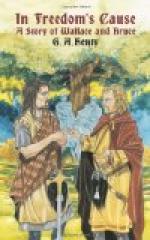At their head rode two men perhaps forty years old, while a lad of some eighteen years of age rode beside them. In one of the elder men Archie recognized Sir John Kerr. The lad beside him was his son Allan. The other leader was Sir John Hazelrig, governor of Lanark; behind them rode a troop of armed men, twenty in number. Some of the lads would have ceased from their play; but Archie exclaimed:
“Heed them not; make as if you did not notice them. You need not be in such a hurry to vail your bonnets to the Kerr.”
“Look at the young dogs,” Sir John Kerr said to his companion. “They know that their chief is passing, and yet they pretend that they see us not.”
“It would do them good,” his son exclaimed, “did you give your troopers orders to tie them all up and give them a taste of their stirrup leathers.”
“It would not be worth while, Allan,” his father said. “They will all make stout men-at-arms some day, and will have to fight under my banner. I care as little as any man what my vassals think of me, seeing that whatsoever they think they have to do mine orders. But it needs not to set them against one needlessly; so let the varlets go on with their play undisturbed.”
That evening Archie said to his mother, “How is it, mother, that the English knight whom I today saw ride past with the Kerr is governor of our Scottish town of Lanark?”
“You may well wonder, Archie, for there are many in Scotland of older years than you who marvel that Scotsmen, who have always been free, should tolerate so strange a thing. It is a long story, and a tangled one; but tomorrow morning I will draw out for you a genealogy of the various claimants to the Scottish throne, and you will see how the thing has come about, and under what pretence Edward of England has planted his garrisons in this free Scotland of ours.”
The next morning Archie did not forget to remind his mother of her promise.
“You must know,” she began, “that our good King Alexander had three children — David, who died when a boy; Alexander, who married a daughter of the Count of Flanders, and died childless; and a daughter, Margaret, who married Eric, the young King of Norway. Three years ago the Queen of Norway died, leaving an only daughter, also named Margaret, who was called among us the `Maid of Norway,’ and who, at her mother’s death, became heir presumptive to the throne, and as such was recognized by an assembly of the estates at Scone. But we all hoped that the king would have male heirs, for early last year, while still in the prime of life, he married Joleta, daughter of the Count of Drew. Unhappily, on the 19th of March, he attended a council in the castle of Edinburgh, and on his way back to his wife at Kinghorn, on a stormy night, he fell over a precipice and was killed.
“The hopes of the country now rested on the `Maid of Norway,’ who alone stood between the throne and a number of claimants, most of whom would be prepared to support their claims by arms, and thus bring unnumbered woes upon Scotland. Most unhappily for the country, the maid died on her voyage to Scotland, and the succession therefore became open.




